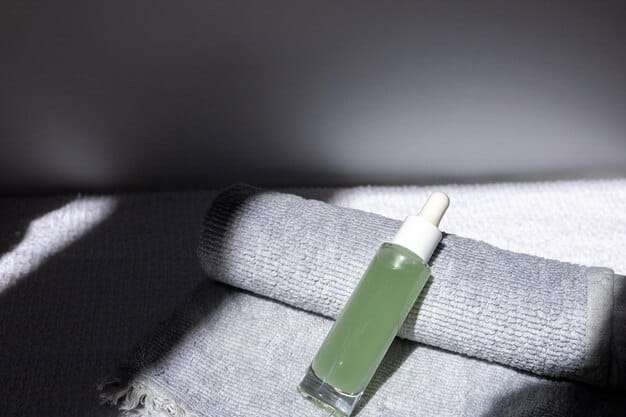Men’s Sunscreen: Year-Round Need & Top 5 Broad Spectrum Options for 2025

Year-round sunscreen use is vital for men’s skin health, protecting against UV damage, premature aging, and skin cancer, with broad-spectrum options recommended for comprehensive defense against UVA and UVB rays for 2025.
The idea that sunscreen is only for beach days or summer vacations is a lingering myth, especially among men. However, consistent and year-round use of sunscreen for men is a non-negotiable step in any effective skincare regimen. As we approach 2025, understanding why this daily defense is crucial—and selecting the right broad-spectrum products—becomes even more important for maintaining healthy, resilient skin. This article explores the science behind year-round sun protection and spotlights the top five broad-spectrum sunscreen options tailored for men.
The Undeniable Need for Year-Round Sun Protection for Men
Many men might think of sunscreen only when hitting the beach or engaging in intense outdoor sports under clear skies. This perception, though common, largely overlooks the fundamental reality of UV radiation: it’s present every single day, regardless of the weather or season. Whether it’s a cloudy winter morning, a brisk autumn afternoon, or a spring day spent commuting, your skin is continuously exposed to ultraviolet (UV) rays, necessitating consistent protection.
The sun emits two primary types of UV radiation that affect skin health: UVA and UVB rays. UVA rays penetrate deep into the skin, contributing significantly to premature aging, including wrinkles, fine lines, and sun spots. They can also pass through glass, meaning you’re exposed even while driving or sitting inside by a window. UVB rays are the primary cause of sunburn and play a crucial role in the development of most skin cancers. Both types contribute to DNA damage in skin cells and increase the risk of skin cancer, including melanoma, the most dangerous form.
Understanding UVA and UVB Rays
UVA rays are often called the “aging rays” because they are a major contributor to long-term skin damage, extending beyond mere sunburn. They are less intense than UVB rays but are present with consistent intensity throughout the year, from dawn till dusk. They can penetrate clouds and glass, making indoor exposure a reality for many. The cumulative effect of UVA exposure can lead to significant breakdown of collagen and elastin, affecting skin elasticity and firmness over time.
- Constant presence: UVA rays are present all year, regardless of season or weather.
- Deep penetration: They reach deeper skin layers, causing lasting structural damage.
- Aging effects: Primarily responsible for wrinkles, fine lines, and sunspots.
UVB rays, on the other hand, are the “burning rays.” Their intensity fluctuates more widely with seasonal changes, peaking in summer months and at higher altitudes. These rays are the primary culprits behind sunburn, a clear sign of skin damage. While the immediate effects of UVB are more visible, their long-term impact includes increased risk of skin cancer and pigmentary changes.
- Seasonal fluctuation: Most intense during summer, at high altitudes, and closer to the equator.
- Surface damage: Primarily affect the skin’s superficial layers.
- Sunburn cause: Directly responsible for the redness and pain associated with sunburn.
For men, who often spend considerable time outdoors for work, hobbies, or sports, this consistent exposure can accumulate rapidly. Furthermore, men statistically have a higher incidence of non-melanoma skin cancers than women, partly due to less consistent sun protection habits and greater occupational exposure. Incorporating sunscreen daily is not just a cosmetic choice; it’s a critical health decision that mitigates the long-term risks associated with chronic UV exposure.
Beyond Sunburn: The Long-Term Benefits of Daily Sunscreen Use
While avoiding the immediate discomfort of a sunburn is an obvious benefit of sunscreen, the long-term advantages of consistent daily application extend far beyond that. For men, who might prioritize practicality and efficiency in their routines, understanding these deeper benefits can be a strong motivator to adopt a more rigorous sun protection strategy. Daily sunscreen use is an investment in both your present appearance and your future health, offering protection against a range of dermatological issues that can impact quality of life.
One of the most significant long-term benefits is the prevention of premature skin aging, often referred to as photoaging. UV radiation breaks down collagen and elastin fibers in the skin, which are essential for maintaining its structure and elasticity. Over time, this breakdown leads to the formation of wrinkles, fine lines, and sagging skin, making you appear older than your chronological age. Regular sunscreen use acts as a shield, preserving these crucial proteins and maintaining a youthful skin appearance.
Protecting Your Skin’s Health and Appearance
Beyond visible signs of aging, chronic sun exposure can lead to other skin concerns often seen in men due to lack of consistent protection. This includes hyperpigmentation issues like sunspots, age spots (lentigines), and uneven skin tone, which can be challenging to reverse once established. Sunscreen helps prevent the overproduction of melanin, which is responsible for these dark spots, thereby maintaining a more even and clear complexion. It also reduces the likelihood of developing telangiectasias, commonly known as spider veins, which are small, visible blood vessels near the skin surface.
Crucially, daily sunscreen significantly lowers the risk of skin cancer. Skin cancer, including basal cell carcinoma, squamous cell carcinoma, and melanoma, is the most common form of cancer, and UV radiation is its primary cause. Men, particularly white men over 50, have statistically higher rates of non-melanoma skin cancers and are at greater risk of developing melanoma. Making sunscreen a daily habit dramatically reduces the DNA damage in skin cells that can lead to cancerous growths, serving as a vital preventive measure against these potentially life-threatening conditions.
- Reduced risk of skin cancer: Drastically lowers the incidence of melanoma, basal cell, and squamous cell carcinomas.
- Prevention of photoaging: Minimizes wrinkles, fine lines, and sagging, maintaining youthful skin.
- Even skin tone: Prevents sunspots, age spots, and hyperpigmentation for a clearer complexion.
- Maintained skin barrier: Helps preserve the skin’s natural protective barrier, leading to healthier skin.
Furthermore, sunscreen actively helps maintain the skin’s overall integrity and health. By protecting the skin barrier from UV-induced inflammation and damage, it supports the skin’s natural repair processes and resilience. This can lead to less irritation, improved hydration, and a healthier appearance overall. For men engaged in outdoor activities, this added layer of protection ensures their skin remains strong and able to withstand environmental stressors, contributing to long-term skin vitality and reducing the need for corrective treatments later in life.

Choosing the Right Armor: Broad Spectrum Sunscreen Explained
When selecting a sunscreen, the term “broad-spectrum” is paramount, especially for men committing to year-round protection. This designation isn’t just marketing jargon; it’s a critical indicator that the product offers comprehensive defense against both UVA and UVB rays. Without broad-spectrum coverage, you’re only getting partial protection, leaving your skin vulnerable to significant damage from one of the UV spectrums. Understanding what broad-spectrum means and how to find it on a label is essential for making an informed choice that truly safeguards your skin.
Broad-spectrum sunscreens are formulated to block or reflect both types of harmful UV radiation. While UVB protection prevents sunburn, UVA protection is crucial for preventing long-term skin aging and reducing the risk of skin cancer. Many older sunscreens or products not explicitly labeled broad-spectrum might only offer primary UVB protection. This can create a false sense of security, as users might believe they are fully protected when, in reality, their skin is still susceptible to the deep-penetrating damage caused by UVA rays, which can lead to premature aging and increased cancer risk.
Decoding SPF and PA Ratings
Beyond broad-spectrum, two other key metrics to look for are SPF and, for those products using it, the PA rating system. SPF (Sun Protection Factor) primarily measures how well a sunscreen protects against UVB rays, indicating how much longer it takes for skin to redden when using the product compared to bare skin. For daily use, most dermatologists recommend an SPF of 30 or higher, as it blocks approximately 97% of UVB rays. Higher SPFs offer only marginally better protection, for example, SPF 50 blocks about 98%.
- SPF 30+: Ideal for daily use, blocking about 97% of UVB rays.
- Higher SPF: Offers slightly more protection but no substantial additional benefits once above SPF 50.
- Regular reapplication: Crucial for effectiveness, regardless of SPF, especially after sweating or swimming.
While SPF indicates UVB protection, the PA rating system (Protection Grade of UVA) is often used outside the US to specifically denote UVA protection levels. It ranges from PA+ to PA++++, with more plus signs indicating stronger UVA protection. In the US, broad-spectrum labeling indicates both UVA and UVB protection, but checking ingredients like zinc oxide, titanium dioxide, avobenzone, or ecamsule is also helpful, as these are known UVA blockers.
- PA++++: Highest level of UVA protection in this system.
- Broad-spectrum label: Key indicator for combined UVA/UVB protection in the US.
- Ingredient check: Look for zinc oxide, titanium dioxide, avobenzone, or ecamsule for robust UVA defense.
When choosing a broad-spectrum sunscreen, also consider the formulation. For daily facial use, a non-comedogenic (won’t clog pores) and lightweight formula is preferable, especially for men prone to breakouts or with oily skin. Water-resistant formulas are excellent for active men, but remember that “water-resistant” doesn’t mean “waterproof”; reapplication after sweating and swimming is always necessary to maintain effective protection.
Mineral vs. Chemical: Which Sunscreen Type is Right for You?
Deciding between mineral (physical) and chemical sunscreens is a common dilemma, and for men seeking effective, year-round sun protection, understanding the differences can help tailor their choice to personal preferences and skin needs. Both types offer broad-spectrum protection, but they achieve it through distinct mechanisms and possess different characteristics regarding feel, application, and potential skin reactions. The “best” type often comes down to individual skin sensitivity, lifestyle, and aesthetic preference.
Mineral sunscreens, also known as physical sunscreens, work by creating a physical barrier on the skin’s surface that reflects and scatters UV rays away from the skin. Their active ingredients are typically zinc oxide and titanium dioxide. These ingredients are generally considered “reef-safe” and are often recommended for individuals with sensitive skin, children, or those prone to acne, as they are less likely to cause irritation or allergic reactions. The main challenge with older mineral formulations was the tendency to leave a white cast, particularly on darker skin tones, but modern formulations have significantly improved in this aspect, often blending seamlessly.
The Science Behind Sunscreen Varieties
Zinc oxide and titanium dioxide sit on top of the skin and physically block the sun’s rays. This physical barrier begins protecting the skin immediately upon application, making them a good choice if you need instant protection. Their non-irritating nature means they are less likely to aggravate conditions like rosacea or eczema. While some men might still find the texture slightly thicker than chemical counterparts, advancements in micronization and non-nano particle technology have made these formulas much more cosmetically elegant, often appearing sheer or tinted.
- Mechanism: Physical barrier that reflects UV rays.
- Active ingredients: Zinc oxide, titanium dioxide.
- Benefits: Gentle, ideal for sensitive skin, immediate protection.
- Consideration: May leave a slight white cast, though modern formulas are much improved.
Chemical sunscreens, conversely, work by absorbing UV rays as they penetrate the skin and then converting them into heat, which is released from the skin. Common active ingredients include oxybenzone, avobenzone, octinoxate, and octisalate. These sunscreens are often favored for their lighter texture, easier spreadability, and lack of a white cast, making them a popular choice for daily wear and for those who prefer an invisible finish. Chemical sunscreens need about 15-20 minutes to fully absorb and become effective after application.
- Mechanism: Absorbs UV rays and converts them into heat.
- Active ingredients: Oxybenzone, avobenzone, octinoxate, octisalate, etc.
- Benefits: Lightweight, spreads easily, no white cast.
- Consideration: May cause irritation in highly sensitive individuals, requires absorption time.
For men, the choice often comes down to their skin type and personal preference for texture. If you have sensitive skin, or prefer a “cleaner” ingredient list, mineral sunscreens might be a better fit. If you prioritize a lightweight, utterly invisible finish that easily integrates into your routine, especially if you have facial hair, a modern chemical sunscreen could be ideal. Many brands also offer hybrid formulas that combine mineral and chemical filters, aiming to offer the best of both worlds with broad-spectrum protection, gentle ingredients, and a pleasant texture. Always choose a broad-spectrum option, regardless of the type, to ensure comprehensive protection.
Top 5 Broad Spectrum Sunscreen Options for Men in 2025
As we advance into 2025, the market for effective and user-friendly broad-spectrum sunscreens for men continues to evolve, offering improved formulations that address common concerns like greasy residue, white cast, and uncomfortable textures. Selecting the right product is crucial for ensuring consistent, year-round sun protection that fits seamlessly into a man’s daily routine. Below are five top-tier broad-spectrum sunscreens that stand out for their effectiveness, ingredients, and overall user experience, catering to various skin types and preferences.
1. EltaMD UV Clear Broad-Spectrum SPF 46
EltaMD UV Clear remains a perennial favorite, particularly for men with sensitive, acne-prone, or rosacea-prone skin. It’s a mineral-based sunscreen (zinc oxide) that also contains niacinamide, a form of Vitamin B3, which helps reduce redness and inflammation, making it excellent for calming irritated skin. Its lightweight, oil-free formula applies smoothly with no white cast, absorbing quickly to leave a clear finish. It’s non-comedogenic, ensuring it won’t clog pores, which is a major plus for daily use. While slightly pricier, its dermatological benefits and pleasant texture make it a worthwhile investment for consistent protection.
2. Supergoop! Unseen Sunscreen SPF 40
For the man who despises the feeling of sunscreen, Supergoop! Unseen Sunscreen is a game-changer. This chemical sunscreen offers a truly invisible, weightless, and scentless finish, making it perfect for men with or without facial hair. Its unique primer-like texture creates a smooth base for any other products or simply on its own. It’s oil-free, non-comedogenic, and packed with nourishing ingredients like red algae, which helps protect against blue light. Its ability to disappear into the skin makes it an effortless daily choice, ensuring consistent application.
3. CeraVe Hydrating Mineral Sunscreen SPF 50 Face Lotion
CeraVe offers an accessible yet highly effective mineral sunscreen that combines essential broad-spectrum protection with skin barrier repair. Formulated with zinc oxide and titanium dioxide, it provides reliable protection while incorporating three essential ceramides to help restore and maintain the skin’s natural barrier. This makes it an excellent choice for men with dry or normal skin, or those looking to simplify their routine with a combined moisturizer and sunscreen. It’s non-comedogenic, fragrance-free, and designed to be gentle, minimizing the risk of irritation.

4. Jack Black Double-Duty Face Moisturizer SPF 20
While its SPF is lower than others on this list, Jack Black Double-Duty Face Moisturizer is an excellent choice for men seeking a single product that combines hydration with adequate daily sun protection for typical indoor/outdoor exposure. Its broad-spectrum SPF 20 (chemical filters) offers good basic defense, while the moisturizer component hydrates and conditions the skin. It’s a lightweight, non-greasy formula that absorbs quickly, containing blue algae extract and sea parsley for antioxidant benefits. For extensive outdoor activity, a higher SPF is recommended, but for daily office work or quick errands, this provides convenient and consistent protection.
5. La Roche-Posay Anthelios Melt-in Milk Sunscreen SPF 60
La Roche-Posay Anthelios is celebrated globally for its high-performance sunscreens, and the Melt-in Milk SPF 60 is no exception. This broad-spectrum chemical sunscreen offers powerful protection with a luxurious, non-greasy texture that truly “melts” into the skin. It’s water-resistant for up to 80 minutes, making it ideal for active men who sweat or swim regularly. Its formulation is rigorously tested and suitable for sensitive skin, free of fragrance and parabens. The high SPF offers robust protection against intense sun exposure, ensuring comprehensive defense even in challenging conditions.
When selecting your preferred broad-spectrum sunscreen from these options, consider not just the SPF and active ingredients, but also how it feels on your skin and how well it integrates into your morning routine. A sunscreen must be worn consistently, so choosing one that you genuinely enjoy applying is often the most important factor in ensuring year-round protection.
Application Best Practices for Optimal Protection
Having the right broad-spectrum sunscreen is only half the battle; knowing how to apply it correctly is equally crucial for achieving optimal, year-round protection. Many men might underestimate the amount needed or the frequency of reapplication, inadvertently leaving their skin vulnerable to UV damage. Mastering these application best practices ensures that your skin receives the full protective benefits your chosen sunscreen is designed to deliver, safeguarding your health and appearance in the long run.
The first and most common mistake is applying too little sunscreen. Dermatologists recommend using approximately one ounce (a shot glass full) for the entire body, and a nickel-sized dollop for the face and neck. For men, especially those with facial hair, ensuring even coverage is key; apply in sections and gently rub it in, making sure to cover areas often missed, like the ears, neck, scalp (if balding or thinning), and the back of the hands. Consistent and thorough coverage ensures no unprotected areas are exposed to harmful UV rays.
Techniques for Maximizing Sunscreen Effectiveness
Timing of application is also critical. Chemical sunscreens need about 15-20 minutes to fully absorb into the skin and become effective before sun exposure. Mineral sunscreens, on the other hand, offer immediate protection upon application. Regardless of type, applying sunscreen as the final step in your morning skincare routine, after moisturizers but before makeup (if applicable), ensures it forms the outermost protective layer on your skin.
- Adequate amount: Use a nickel-sized dollop for the face and neck; one shot glass for the body.
- Even coverage: Ensure every exposed area, including ears, neck, and bald spots, is covered.
- Timing: Apply chemical sunscreens 15-20 minutes before sun exposure; mineral sunscreens work immediately.
Reapplication is another often-overlooked step. Sunscreen’s effectiveness diminishes over time due to sweat, water, and simple degradation from sun exposure. Even on cloudy days or during low-intensity activities, sunscreen should be reapplied at least every two hours. If you’re sweating heavily, swimming, or towel-drying, reapply more frequently, typically every 40 to 80 minutes, depending on the product’s water-resistance rating. This consistent reapplication ensures a continuous shield against UV radiation throughout the day.
- Every two hours: Standard reapplication frequency for general use.
- More often: Reapply every 40-80 minutes if swimming, sweating heavily, or towel-drying.
- Don’t forget: Apply before and after breaks, even if briefly indoors.
Lastly, don’t solely rely on sunscreen for protection, especially for prolonged outdoor activity. Sunscreen is one component of a holistic sun protection strategy. Seek shade during peak sun hours (10 AM to 4 PM), wear sun-protective clothing (UPF-rated apparel), hats, and UV-blocking sunglasses. Combining these measures provides the most comprehensive defense against the sun’s damaging rays, complementing your diligent sunscreen application and maximizing your skin’s health and longevity.
Debunking Common Sunscreen Myths for Men
Misconceptions about sunscreen are pervasive, and for many men, these myths can be significant barriers to consistent and effective year-round sun protection. Debunking these common beliefs is essential for fostering a deeper understanding of UV hazards and encouraging adoption of robust sun-safety practices. By separating fact from fiction, men can make more informed decisions about their skin health, ensuring they receive the full benefits of broad-spectrum sunscreen protection.
One prevalent myth is “I don’t need sunscreen on cloudy days.” This is dangerously untrue. Up to 80% of the sun’s UV rays can penetrate clouds, meaning your skin is still exposed to significant radiation even on overcast days. Both UVA and UVB rays can pass through cloud cover, contributing to aging, sunburn, and skin cancer risk. This myth often leads to unprotected exposure, especially during cooler months when people feel less immediate threat from the sun.
Myth vs. Reality: Clearing the Air on Sun Protection
Another common belief, especially among men, is “I rarely get sunburned, so I don’t need sunscreen.” While some skin types may be less prone to visible sunburn, the absence of redness doesn’t mean your skin is immune to UV damage. UVA rays, which don’t cause sunburn, still penetrate deeply, causing photoaging and DNA damage that can lead to skin cancer. Cumulative sun exposure, even without obvious burns, significantly increases long-term risks. Every skin type, regardless of its propensity to burn, needs sun protection year-round to mitigate these unseen damages.
- Myth: Sunscreen is only for beach days.
- Reality: UV rays are present daily, year-round, requiring consistent use.
- Myth: My skin doesn’t burn, so I’m safe.
- Reality: All skin types are susceptible to aging and cancer-causing UV damage, even without sunburn.
The myth that “sunscreen prevents vitamin D absorption” also deters some from consistent use. While sunscreen does block some UV-B rays, which are necessary for Vitamin D synthesis, studies show that regular sunscreen use doesn’t lead to widespread Vitamin D deficiency. Most people get sufficient Vitamin D through brief, incidental sun exposure, fortified foods, and supplements without compromising their sun protection. The health benefits of sun protection far outweigh any minimal reduction in Vitamin D synthesis from sunscreen use. For adequate vitamin D levels, a balanced diet and physician-recommended supplements are more reliable sources.
- Myth: I get enough sun from short exposures.
- Reality: Brief, unprotected exposures add up, causing cumulative damage.
- Myth: Sunscreen blocks vitamin D.
- Reality: Sunscreen does not typically cause vitamin D deficiency, and other sources are readily available.
By dispelling these myths, men can adopt a more realistic and responsible approach to sun protection. Understanding that UV radiation is an ever-present environmental factor requires a consistent defense strategy. Daily, year-round use of broad-spectrum sunscreen is not an optional seasonal accessory but a fundamental component of proactive health and anti-aging skincare for all men, regardless of their skin type or outdoor activity level.
| Key Point | Brief Description |
|---|---|
| 🗓️ Year-Round Need | UV rays are present daily, regardless of weather or season, requiring consistent protection for men’s skin health. |
| 🛡️ Broad Spectrum | Crucial for defending against both UVA (aging) and UVB (burning) rays, preventing long-term skin damage and cancer. |
| 🧴 Top Options (2025) | EltaMD, Supergoop!, CeraVe, Jack Black (lower SPF), and La Roche-Posay offer tailored options for various skin types. |
| ✅ Proper Application | Applying adequate amounts and reapplying every 2 hours (or more when active) ensures optimal protection. |
Frequently Asked Questions About Men’s Sunscreen Use
Year-round sunscreen is essential because UV radiation is present every day, regardless of weather or season. It protects men’s skin from constant exposure to UVA and UVB rays, which cause premature aging, wrinkles, sunspots, and significantly increase the risk of various skin cancers. Consistent daily use safeguards both skin health and appearance over the long term.
“Broad-spectrum” means a sunscreen protects against both UVA and UVB rays. UVA rays contribute to aging (wrinkles, sunspots), while UVB rays cause sunburn and are a primary cause of skin cancer. Comprehensive broad-spectrum protection is vital for men to prevent both visible damage and reduce the risk of serious health issues from all forms of sun exposure.
For general daily use, sunscreen should be reapplied at least every two hours. If engaging in activities that cause sweating, swimming, or if towel-drying, reapply more frequently—typically every 40 to 80 minutes, depending on the product’s water-resistance rating. Consistent reapplication is crucial for maintaining effective protection throughout the day.
Neither is inherently “better,” as the choice often depends on individual skin type and preference. Mineral sunscreens (zinc oxide, titanium dioxide) form a physical barrier, often preferred for sensitive skin. Chemical sunscreens absorb UV rays, generally offering a lighter, more invisible finish. Both types are effective if they are broad-spectrum and applied correctly.
Some sunscreens can clog pores, especially those with heavy or greasy formulations. Men prone to breakouts should look for sunscreens labeled “non-comedogenic” (meaning they won’t clog pores) and “oil-free.” Lightweight, gel, or fluid formulations are generally less likely to cause acne and are more comfortable for daily wear.
Conclusion
The commitment to year-round sunscreen use is a vital step in maintaining optimal skin health for men. Beyond preventing immediate sunburn, consistent application of broad-spectrum products acts as a powerful defense against premature aging, hyperpigmentation, and most crucially, the significant threat of skin cancer. By understanding the pervasive nature of UV radiation and choosing formulas tailored to their needs, men can seamlessly integrate sun protection into their daily routine. This simple yet profound habit is an investment in long-term wellness, ensuring healthier, more resilient skin for years to come. Prioritizing sun safety today paves the way for a healthier skin future in 2025 and beyond.





